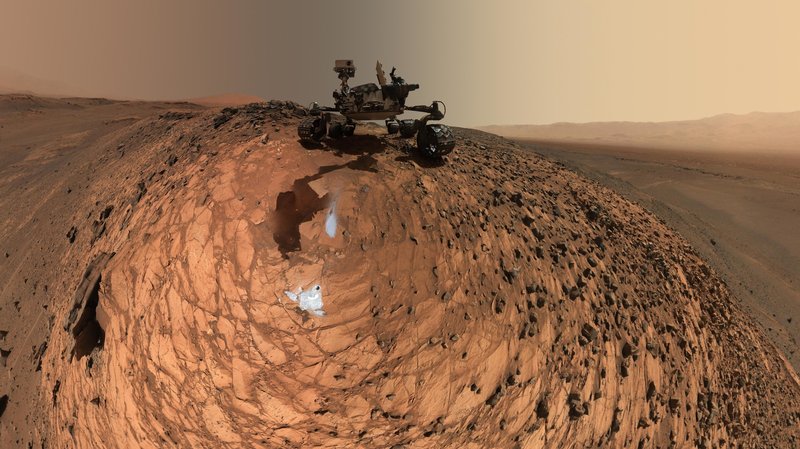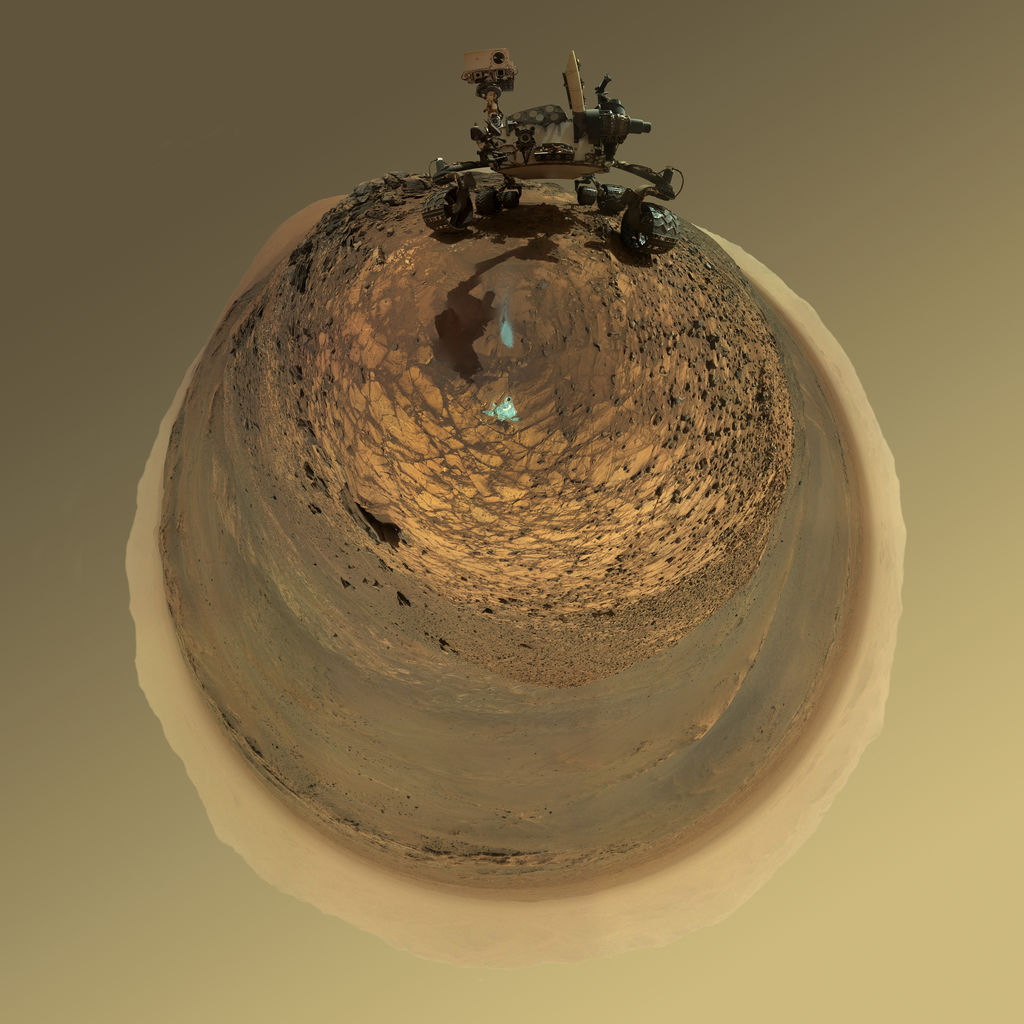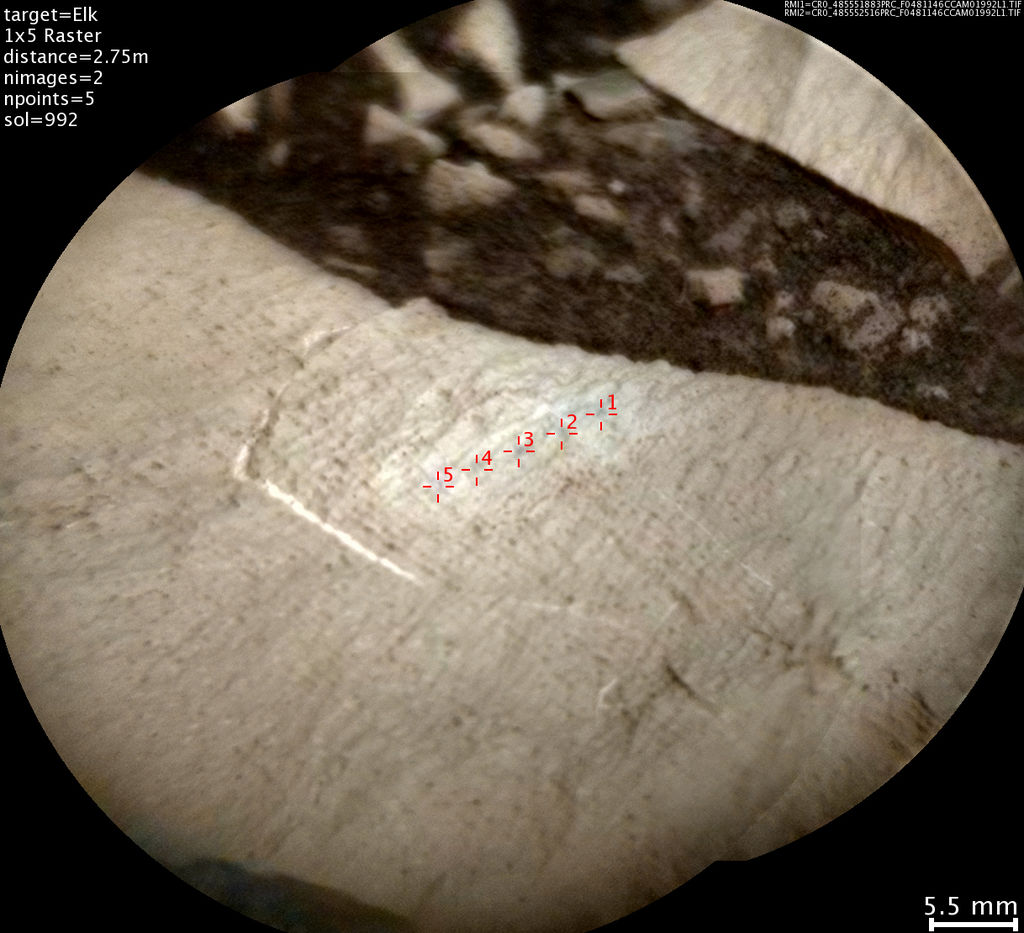
 |
|
Curiouser
And Curiouser: NASA's Curiosity
Rover Finds Piles Of Silica On
Mars
 After
it drilled two holes in the "Buckskin" rock on
Mars, the Curiosity rover took a series of
photos that were turned into this
panoramic self-portrait. The rover is sitting on
the crest of a 20-foot hill. NASA/JPL-Caltech/MSSS
NASA's Curiosity Mars rover
is driving toward the southwest after departing a
region where for several weeks it investigated a
geological contact zone and rocks that are
unexpectedly high in silica and hydrogen content.
The hydrogen indicates water bound to minerals in
the ground.
In this "Marias Pass" region, Curiosity successfully used its drill to sample a rock target called "Buckskin" and then used the camera on its robotic arm for multiple images to be stitched into a self-portrait at the drilling site. The new Curiosity selfie from a dramatically low angle is online at: Looking Up at Mars Rover Curiosity in 'Buckskin' Selfie (Click on image for full size) This low-angle self-portrait of NASA's Curiosity Mars rover shows the vehicle at the site from which it reached down to drill into a rock target called "Buckskin." The MAHLI camera on Curiosity's robotic arm took multiple images on Aug. 5, 2015, that were stitched together into this selfie. Credit: NASA/JPL-Caltech/MSSS The rover finished activities in Marias Pass on Aug. 12 and headed onward up Mount Sharp, the layered mountain it reached in September 2014. In drives on Aug. 12, 13, 14 and 18, it progressed 433 feet (132 meters), bringing Curiosity's total odometry since its August 2012 landing to 6.9 miles (11.1 kilometers). Curiosity is carrying with it some of the sample powder drilled from Buckskin. The rover's internal laboratories are analyzing the material. The mission's science team members seek to understand why this area bears rocks with significantly higher levels of silica and hydrogen than other areas the rover has traversed. Silica, monitored with Curiosity's laser-firing Chemistry and Camera (ChemCam) instrument, is a rock-forming chemical containing silicon and oxygen, commonly found on Earth as quartz. Hydrogen in the ground beneath the rover is monitored by the rover's Dynamic Albedo of Neutrons (DAN) instrument. It has been detected at low levels everywhere Curiosity has driven and is interpreted as the hydrogen in water molecules or hydroxyl ions bound within or absorbed onto minerals in the rocks and soil. "The ground about 1 meter beneath the rover in this area holds three or four times as much water as the ground anywhere else Curiosity has driven during its three years on Mars," said DAN Principal Investigator Igor Mitrofanov of Space Research Institute, Moscow. DAN first detected the unexpectedly high level of hydrogen using its passive mode. Later, the rover drove back over the area using DAN in active mode, in which the instrument shoots neutrons into the ground and detects those that bounce off the subsurface, but preferentially interacting with hydrogen. The measurements confirmed hydrated material covered by a thin layer of drier material. Curiosity initially noted the area with high silica and hydrogen on May 21 while climbing to a site where two types of sedimentary bedrock lie in contact with each other. Such contact zones can hold clues about ancient changes in environment, from conditions that produced the older rock type to conditions that produced the younger one. This contact is the lure that led the rover team to choose Marias Pass as a route toward higher layers of Mount Sharp. Pale mudstone, like bedrock the mission examined for the first several months after reaching Mount Sharp at an area called "Pahrump Hills," forms one side of the contact. The overlying side is darker, finely bedded sandstone. Curiosity examined the Marias Pass contact zone closely with instruments mounted on its mast and arm. The unusual levels of silica and hydrogen in rocks passed during the climb prompted a choice to backtrack to examine that area and acquire a drilled sample. Buckskin was the first rock drilled by Curiosity since an electrical circuit in the drill's percussion mechanism exhibited a small, transient short circuit in February during transfer of sample powder from the third target drilled in the Pahrump Hills area.  Round-Horizon
Version of Curiosity's Low-Angle Selfie at
'Buckskin'
Credit: NASA/JPL-Caltech/MSSS "We were pleased to see no repeat of the short circuit during the Buckskin drilling and sample transfer," said Steven Lee, deputy project manager for Curiosity at NASA's Jet Propulsion Laboratory, Pasadena, California. "It could come back, but we have made changes in fault protection to continue safely drilling even in the presence of small shorts. We also improved drill percuss circuit telemetry to gain more diagnostic information from any future occurrences." Curiosity reached the base of Mount Sharp after two years of fruitfully investigating outcrops closer to its landing site and trekking to the mountain. The main mission objective now is to examine layers of lower Mount Sharp for ancient habitable environments and evidence about how early Mars environments evolved from wetter to drier conditions Sources:
|
|
|
Much
higher concentrations of silica
indicate “considerable water
activity”
LOS ALAMOS, N.M., Dec. 17,
2015—New findings by NASA’s Mars Curiosity rover
are the focus of a press conference this morning
at the American Geophysical Union (AGU) meeting in
San Francisco, Calif. A group of scientists,
including one from Los Alamos National Laboratory,
revealed that the Curiosity rover found much
higher concentrations of silica at some sites the
rover has investigated in the past seven months
than anywhere else it has visited since landing on
Mars 40 months ago. Silica makes up nine-tenths of
the composition of some of the rocks.
“The high silica was a surprise,” said Jens Frydenvang of Los Alamos National Laboratory and the University of Copenhagen, also a Curiosity science team member. “While we’re still working with multiple hypotheses on how the silica got so enriched, these hypotheses all require considerable water activity, and on Earth high silica deposits are often associated with environments that provide excellent support for microbial life. Because of this, the science team agreed to make a rare backtrack to investigate it more.” The first discovery was as Curiosity approached the area “Marias Pass,” where a lower geological unit contacts an overlying one. ChemCam, the rover’s laser-firing instrument for checking rock composition from a distance, detected bountiful silica in some targets the rover passed along the way to the contact zone. The ChemCam instrument was developed at Los Alamos in partnership with the French IRAP laboratory in Toulouse and the French Space Agency. Adding information about silica clues was a major emphasis in rover operations over a span of four months and a distance of about one-third of a mile (half a kilometer). It involves many more readings from ChemCam, plus elemental composition measurements by the Alpha Particle X-ray Spectrometeter (APXS) on the rover’s arm and mineral identification of drilled rock-powder samples analyzed by the Chemistry and Mineralogy (CheMin) instrument inside the rover. Curiosity’s science team is working with two main hypotheses to explain the recent findings on Mount Sharp, both of which require water. Water that is acidic would tend to carry other ingredients away and leave silica behind. Alkaline or neutral water could bring in dissolved silica that would be deposited from the solution. Apart from presenting a puzzle about the history of the region where Curiosity is working, the recent findings on Mount Sharp have intriguing threads to what an earlier rover, Spirit, found halfway around Mars. There, signs of sulfuric acidity were observed. Adding to the puzzle, some of the silica found at one rock Curiosity drilled, called “Buckskin,” is in a mineral named tridymite, which is found in Bandelier tuff, common in New Mexico but rare elsewhere, and never before seen on Mars. The usual origin of tridymite on Earth involves high temperatures in igneous or metamorphic rocks, but the finely layered sedimentary rocks examined by Curiosity have been interpreted as lakebed deposits. Curiosity has been studying geological layers of Mount Sharp, starting from the bottom, since 2014, following two years of productive work on the plains surrounding the mountains. The mission delivered evidence in its first year that lakes in the area billions of years ago offered favorable conditions for life, if microbes ever lived on Mars. As Curiosity studies successively younger layers up Mount Sharp’s slopes, the mission is investigating how ancient environmental conditions evolved from lakes, rivers and deltas to the harsh aridity of today’s Mars. Buckskin was the first of three rocks where drilled samples were collected during that period. The CheMin identification of tridymite prompted the team to look at possible explanations for it: "We could solve this by determining whether trydymite in the sediment comes from a volcanic source or has another origin," said Liz Rampe, of Aerodyne Industries at NASA’s Johnson Space Center. “A lot of us are in our labs trying to see if there’s a way to make tridymite without such a high temperature.” Beyond Marias Pass, ChemCam and APXS readings showed a pattern of high silica in pale zones along fractures in the bedrock, linking the silica enrichment there to alteration by fluids that flowed through the fractures and permeated into the bedrock. CheMin analyzed drilled material from a target called “Big Sky” in bedrock away from a fracture and from a fracture-zone target called “Greenhorn.” Greenhorn indeed has much more silica, but not any in the form of tridymite. Much of it is in the form of noncrystalline opal, which can form in many types of environments, including hot springs, acid leaching and other wet settings. “What we’re seeing on Mount Sharp is dramatically different from what we saw in the first two years of the mission,” said Curiosity Project Scientist Ashwin Vasavada of JPL. “There’s so much variability within relatively short distances. The silica is one indicator of how the chemistry changed. It’s such a multifaceted and curious discovery, we’re going to take a while figuring it out.” The ChemCam has just passed 300,000 laser shots on Mars, each of which returns a color spectrum of the resulting plasma. Source: |
|
|
'Marias
Pass,' Contact Zone of Two Martian Rock Units
(Click image for full size)
This May 22, 2015, view from the Mast Camera (Mastcam) in NASA's Curiosity Mars rover shows the "Marias Pass" area where a lower and older geological unit of mudstone -- the pale zone in the center of the image -- lies in contact with an overlying geological unit of sandstone. In detective stories, as the
plot thickens, an unexpected clue often delivers more
questions than answers. In this case, the scene is a
mountain on Mars. The clue: the chemical compound
silica. Lots of silica. The sleuths: a savvy band of
Earthbound researchers whose agent on Mars is NASA's
laser-flashing, one-armed mobile laboratory,
Curiosity.
NASA's Curiosity rover has found much higher concentrations of silica at some sites it has investigated in the past seven months than anywhere else it has visited since landing on Mars 40 months ago. Silica makes up nine-tenths of the composition of some of the rocks. It is a rock-forming chemical combining the elements silicon and oxygen, commonly seen on Earth as quartz, but also in many other minerals. "These high-silica compositions are a puzzle. You can boost the concentration of silica either by leaching away other ingredients while leaving the silica behind, or by bringing in silica from somewhere else," said Albert Yen, a Curiosity science team member at NASA's Jet Propulsion Laboratory, Pasadena, California. "Either of those processes involve water. If we can determine which happened, we'll learn more about other conditions in those ancient wet environments." Water that is acidic would tend to carry other ingredients away and leave silica behind. Alkaline or neutral water could bring in dissolved silica that would be deposited from the solution. Apart from presenting a puzzle about the history of the region where Curiosity is working, the recent findings on Mount Sharp have intriguing threads linked to what an earlier NASA rover, Spirit, found halfway around Mars. There, signs of sulfuric acidity were observed, but Curiosity's science team is still considering both scenarios -- and others -- to explain the findings on Mount Sharp. 'Big Sky' and 'Greenhorn' Drilling Area on Mount Sharp (Click image for full size) This view from the Mast Camera (Mastcam) on NASA's Curiosity Mars rover covers an area in "Bridger Basin" that includes the locations where the rover drilled a target called "Big Sky" on the mission's Sol 1119 (Sept. 29, 2015) and a target called "Greenhorn" on Sol 1137 (Oct. 18, 2015). Adding to the puzzle, some
silica at one rock Curiosity drilled, called
"Buckskin," is in a mineral named tridymite, rare on
Earth and never seen before on Mars. The usual
origin of tridymite on Earth involves high
temperatures in igneous or metamorphic rocks, but
the finely layered sedimentary rocks examined by
Curiosity have been interpreted as lakebed deposits.
Furthermore, tridymite is found in volcanic deposits
with high silica content. Rocks on Mars' surface
generally have less silica, like basalts in Hawaii,
though some silica-rich (silicic) rocks have been
found by Mars rovers and orbiters. Magma, the molten
source material of volcanoes, can evolve on Earth to
become silicic. Tridymite found at Buckskin may be
evidence for magmatic evolution on Mars.
Curiosity has been studying geological layers of Mount Sharp, going uphill, since 2014, after two years of productive work on the plains surrounding the mountain. The mission delivered evidence in its first year that lakes in the area billions of years ago offered favorable conditions for life, if microbes ever lived on Mars. As Curiosity reaches successively younger layers up Mount Sharp's slopes, the mission is investigating how ancient environmental conditions evolved from lakes, rivers and deltas to the harsh aridity of today's Mars. Seven months ago, Curiosity approached "Marias Pass," where two geological layers are exposed in contact with each other. The rover's laser-firing instrument for examining compositions from a distance, Chemistry and Camera (ChemCam), detected bountiful silica in some targets the rover passed on its way to the contact zone. The rover's Dynamic Albedo of Neutrons instrument simultaneously detected that the rock composition was unique in this area. Curiosity's Path During 2015 Studies of Silica-Rich Rocks (Click image for full size) This map shows the route on lower Mount Sharp that NASA's Curiosity followed between April 19, 2015, and Nov. 5, 2015. During this period the mission investigated silica-rich rock targets including "Buckskin," in the "Maria Pass" area, and "Greenhorn," in the "Bridger Basin" area. "The high silica was a surprise
-- so interesting that we backtracked to investigate
it with more of Curiosity's instruments," said Jens
Frydenvang of Los Alamos National Laboratory in New
Mexico and the University of Copenhagen, Denmark.
Gathering clues about silica was a major emphasis in rover operations over a span of four months and a distance of about one-third of a mile (half a kilometer). The investigations included many more readings from ChemCam, plus elemental composition measurements by the Alpha Particle X-ray Spectrometer (APXS) on the rover's arm and mineral identification of rock-powder samples by the Chemistry and Mineralogy (CheMin) instrument inside the rover. Buckskin was the first of three rocks where drilled samples were collected during that period. The CheMin identification of tridymite prompted the team to look at possible explanations: "We could solve this by determining whether trydymite in the sediment comes from a volcanic source or has another origin," said Liz Rampe, of Aerodyne Industries at NASA's Johnson Space Center, Houston. "A lot of us are in our labs trying to see if there's a way to make tridymite without such a high temperature." Beyond Marias Pass, ChemCam and APXS found a pattern of high silica in pale zones along fractures in the bedrock, linking the silica enrichment there to alteration by fluids that flowed through the fractures and permeated into bedrock. CheMin analyzed drilled material from a target called "Big Sky" in bedrock away from a fracture and from a fracture-zone target called "Greenhorn." Greenhorn indeed has much more silica, but not any in the form of tridymite. Much of it is in the form of noncrystalline opal, which can form in many types of environments, including soils, sediments, hot spring deposits and acid-leached rocks.  This image from the Chemistry and Camera (ChemCam) instrument on NASA's Curiosity Mars rover shows detailed texture of a rock target called "Elk" on Mars' Mount Sharp, revealing laminations that are present in much of the Murray Formation geological unit of lower Mount Sharp. "What we're seeing on Mount Sharp is dramatically different from what we saw in the first two years of the mission," said Curiosity Project Scientist Ashwin Vasavada of JPL. "There's so much variability within relatively short distances. The silica is one indicator of how the chemistry changed. It's such a multifaceted and curious discovery, we're going to take a while figuring it out." Discolored Fracture Zones in Martian Sandstone (Click image for full size) This view from NASA's Curiosity Mars rover shows an example of discoloration closely linked to fractures in the Stimson formation sandstone on lower Mount Sharp. The pattern is evident along two perpendicular fractures. Source: |
|
|
|
|
|
FAIR USE
NOTICE: This page contains copyrighted material the
use of which has not been specifically authorized by
the copyright owner. Pegasus Research Consortium
distributes this material without profit to those who
have expressed a prior interest in receiving the
included information for research and educational
purposes. We believe this constitutes a fair use of
any such copyrighted material as provided for in 17
U.S.C § 107. If you wish to use copyrighted material
from this site for purposes of your own that go beyond
fair use, you must obtain permission from the
copyright owner.
All material on these pages, unless
otherwise noted, is © Pegasus Research Consortium 2001-2019 |
 Webpages © 2001-2019 Pegasus Research Consortium |